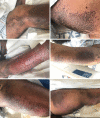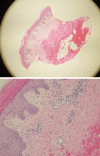Necrolytic acral erythema in a human immunodeficiency virus/hepatitis C virus coinfected patient: A case report
- PMID: 30820272
- PMCID: PMC6393713
- DOI: 10.4254/wjh.v11.i2.226
Necrolytic acral erythema in a human immunodeficiency virus/hepatitis C virus coinfected patient: A case report
Abstract
Background: Necrolytic acral erythema (NAE) is a rare dermatological disorder, which is associated with hepatitis C virus (HCV) infection or zinc deficiency. It is characterized by erythematous or violaceous lesions occurring primarily in the lower extremities. The treatment includes systemic steroids and oral zinc supplementation. We report a case of NAE in a 66-year-old human immunodeficiency virus (HIV)/HCV co-infected woman with NAE. NAE is rarely reported in co-infected patients and the exact mechanisms of pathogenesis are still unclear.
Case summary: A 66-year-old HIV/HCV co-infected female patient presented with painless, non-pruritic rash of extremities for one week and underwent extensive work-up for possible rheumatologic disorders including vasculitis and cryoglobulinemia. Punch skin biopsies of right and left thigh revealed thickened parakeratotic stratum corneum most consistent with NAE. Patient was started on prednisone and zinc supplementation with resolution of the lesions and improvement of rash.
Conclusion: Clinicians should maintain high clinical suspicion for early recognition of NAE in patients with rash and HCV.
Keywords: Case report; Hepatitis C virus; Human immunodeficiency virus; Necrolytic acral erythema; Zinc deficiency.
Conflict of interest statement
Conflict-of-interest statement: The authors declare that they have no conflicts of interest.
Figures


References
-
- Kapoor R, Johnson RA. Necrolytic acral erythema. N Engl J Med. 2011;364:1479–1480. - PubMed
-
- Jakubovic BD, Zipursky JS, Wong N, McCall M, Jakubovic HR, Chien V. Zinc deficiency presenting with necrolytic acral erythema and coma. Am J Med. 2015;128:e3–e4. - PubMed
-
- El-Ghandour TM, Sakr MA, El-Sebai H, El-Gammal TF, El-Sayed MH. Necrolytic acral erythema in Egyptian patients with hepatitis C virus infection. J Gastroenterol Hepatol. 2006;21:1200–1206. - PubMed
-
- Abdallah MA, Ghozzi MY, Monib HA, Hafez AM, Hiatt KM, Smoller BR, Horn TD. Necrolytic acral erythema: a cutaneous sign of hepatitis C virus infection. J Am Acad Dermatol. 2005;53:247–251. - PubMed
Publication types
LinkOut - more resources
Full Text Sources

